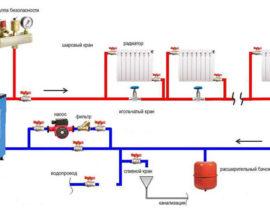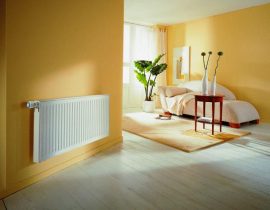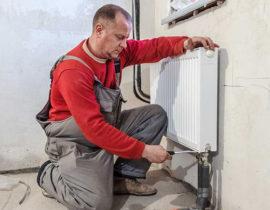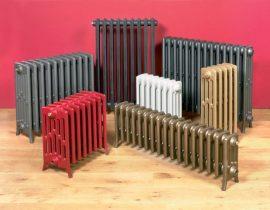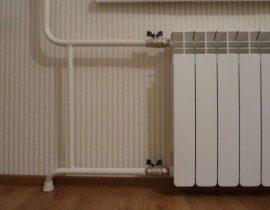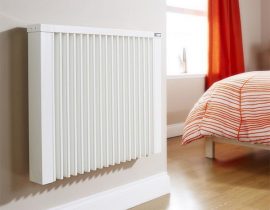The heating system is a large, warm "heart" of the house and a complex engineering structure that does not tolerate approximation and requires competent engineering miscalculation. After all, all this is not just radiators and pipes, but a serious issue of the microclimate in the house, aesthetics and energy saving.

Types of heating radiators for an apartment
Not all radiators on the market today are suitable for installation in an apartment with a central heating system, so the choice should be approached with all responsibility. To understand how to choose the right heating radiators, let's look at their main types.
Content
- Types of radiators that are installed in apartments
- Video. How to install heating radiators
- How do the features and nuances of the central heating system affect the service life of radiators?
- Calculator for calculating the number of sections of heating radiators
- How to choose the right radiators for an apartment?
- Video: How to choose heating radiators
Types of radiators that are installed in apartments
Most often, heating radiators made of the following materials are presented in stores and markets:
- Cast iron.
- Steel (tubular and panel).
- Aluminum.
- Anodized.
- Bimetallic.
- Copper.
- Plastic.
So, which one to choose for an apartment, let's try to figure this issue out together!
Cast iron radiators
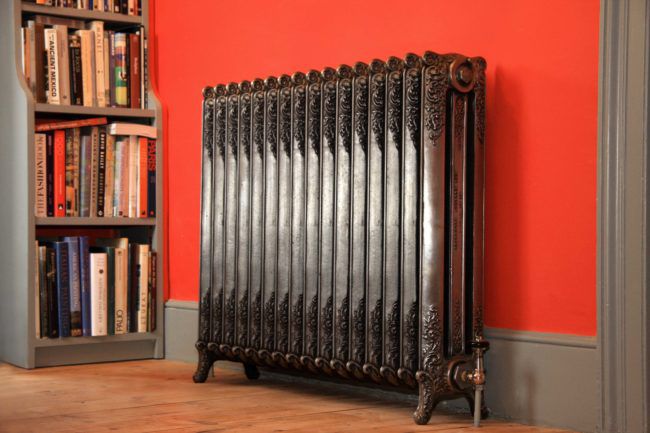
Cast iron radiator
They can be called one of the most "ancient" heating devices, which have not lost their relevance even now.
Due to the peculiarities of cast iron, today these batteries are very popular in our country. Due to the thick walls, they are not afraid of water hammer and are able to withstand a pressure of 25-30 atmospheres. Cast iron radiators are able to function not only in an autonomous heating system, but also in central communication. This material is not subject to corrosion, which makes batteries popular in our country, because, as you know, the heat carrier is often not clean in our country. Another advantage of cast iron batteries is their ability to retain heat for a long time, even after turning off the heating system.
The disadvantages of cast iron batteries include heavy weight, which greatly complicates the installation process. It is impossible to install these radiators alone.
In addition, cast iron has a low thermal conductivity, which is why efficiency is only achieved at a stable temperature of 700C. For a private house or autonomous heating, this can become overhead, but for an apartment solution, with the normal functioning of the central heating system, this is a good option.
In Soviet times, cast-iron sizes were produced in standard sizes.To increase the heating of the apartment, it was necessary to build up the system, which did not always have a positive effect on the aesthetic appearance. Today, on the modern market, there are many options for cast-iron radiators from domestic and foreign manufacturers of different capacities. Therefore, you can pick up small batteries that fit perfectly into the overall concept of the interior. Previously, cast-iron batteries were attached to the wall with brackets. Today, you can choose beautiful floor-mounted radiators that have an elegant look.
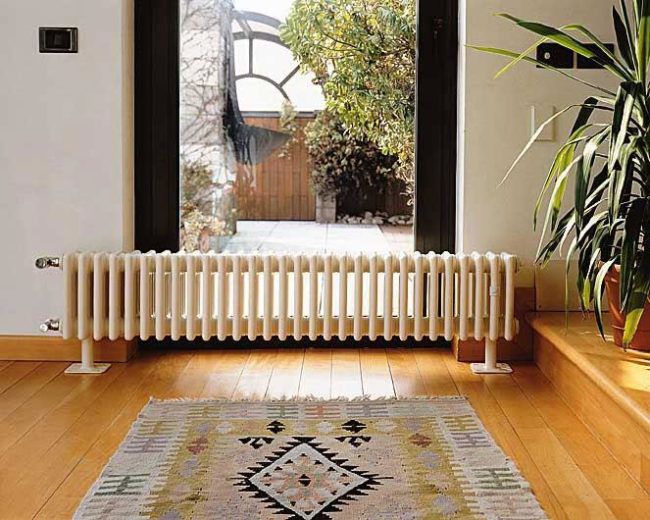
Floor standing cast iron radiator
Modern cast iron batteries do not need additional processing and painting. They are already sold ready for installation, and there is no need to paint them every year. Care for them is minimal: due to the smooth surface, dust practically does not settle on them.
The variety of colors and styles of cast iron batteries today helps not only to harmoniously fit them into a classic or retro style, but also to make radiators a separate decorative element.
Advantages of cast iron radiators:
- Corrosion resistance.
- Stylish appearance.
- Unpretentiousness to the purity of the carrier.
- Affordable price.
- Keep warm for a long time.
- Can function in the central and autonomous heating system.
Flaws:
- Heavy weight.
- Difficulty of installation.
- Takes a long time to reach the desired temperature.
We conclude: for apartments with central heating, the choice of cast-iron radiators is optimal. They will last at least 15-20 years and will effectively give off heat.
Features of mounting cast iron batteries
Given the large weight of cast iron batteries, installation is a rather laborious and difficult process.If you decide to independently install cast-iron radiators, then the following factors must be considered:
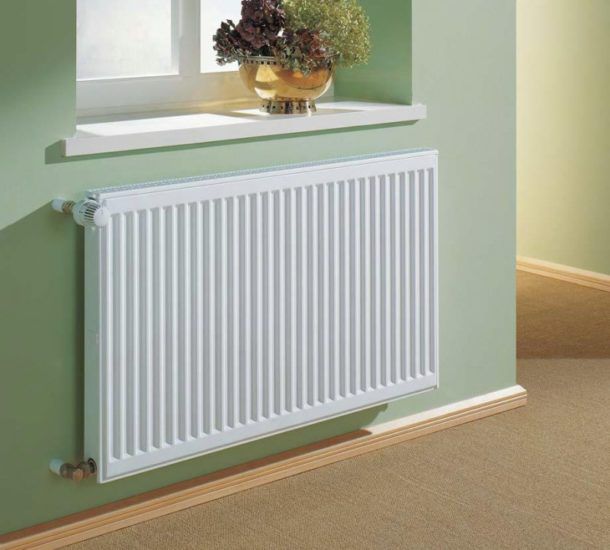 The best place for the battery is under the window | Installation is best done in the summer, when the central heating system is turned off. Determine a place to install the future battery. The best place would be the area under the window. This will ensure the normal circulation of cold and hot air throughout the room. |
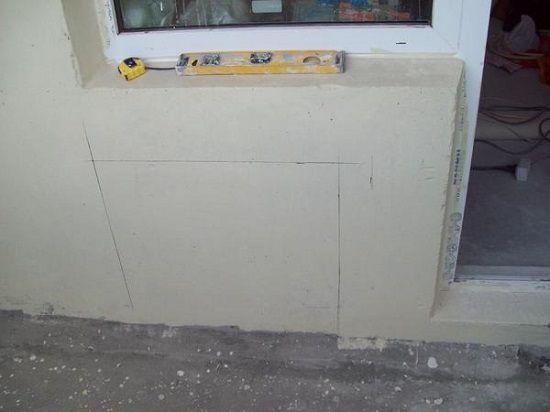 Marking for the battery | Mark the fastenings and the location of the structure on the wall. Use a spirit level to check if the line is level. If the battery is tilted unevenly, air pockets may form during operation. |
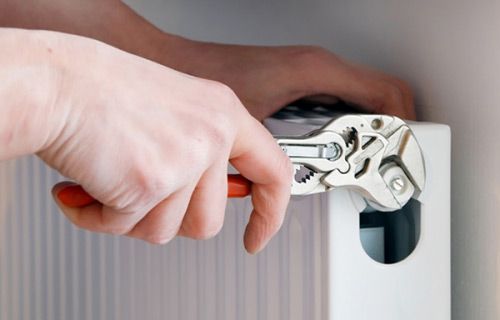 Battery Nipples Adjustment | Before the installation process, adjust the nipples. This is especially true for devices of domestic manufacturers. To do this, you need to unwind the battery, adjust the nipples and assemble everything back. In order to avoid distortion of the nipples, the battery must be disassembled on a radiator workbench using special keys. At the same time, we make one turn on each side to avoid skew. Having unscrewed the nipples, remove the sections. After adjusting the nipples, we assemble back strictly in the reverse order. It is necessary to test whether the battery will leak. We make a "pressure". Only now you can start installation. |
 Bracket mounting example | In concrete and brick walls, cast-iron batteries are attached to the wall using special brackets. This will be enough to keep the battery from tilting under the pressure of the water. A standard size radiator must be secured to the wall with at least four posts.When attaching cast iron batteries to a wooden wall, you need to play it safe and create an additional floor support. The distance from the wall should be - 5 cm, from the floor - 10 cm. Having driven the supports into the wall, install the battery on them immediately on all the brackets. |
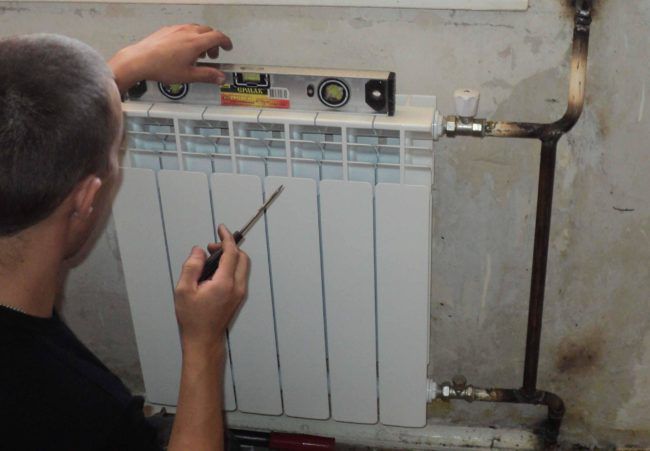 Checking the results of work by the level | The installation process depends on the type of fasteners. Typically, batteries are supplied with four holes located at the corners of the structure. Two openings are used to connect the direct and return lines, the rest are closed with air vent valves and plugs. Connect the battery to the water supply only after checking the level of the horizontal position of the structure. Connect the open ends of the pipes by gas welding to ensure a reliable, tight and durable connection. At the end of all work, check the tightness of the entire structure by turning on the water. |
Steel radiators

Steel radiators
Steel batteries represent the best value for money. They are able to withstand a sufficiently large load and water hammer of the heating system. And due to the high level of thermal conductivity, steel batteries heat up quickly. For autonomous heating or heating a private house, this option is quite practical.
Speaking of steel radiators, it should be mentioned that they are of two types: panel and tubular.
Panel steel batteries
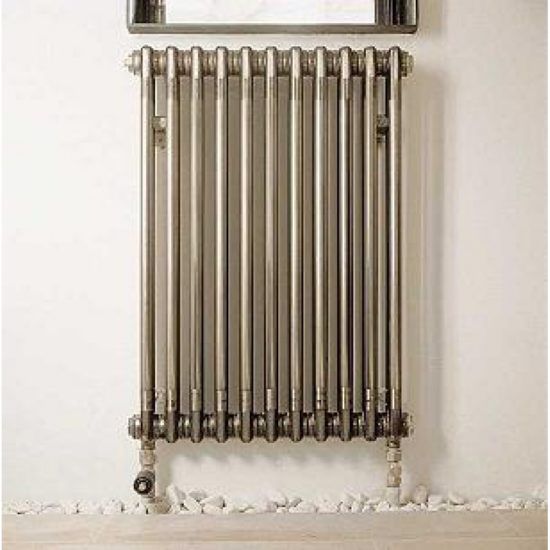
Steel panel battery
Panel radiators are a structure of two steel sheets connected by welding. Some models are equipped with convection elements to create a vertical direction of heated air.This allows you to create a kind of thermal barrier for the cold stream coming from the window.
To ensure strength and durability, the structure is painted only after complete assembly. When buying, be sure to carefully study the coating, as this affects further operation. Corrosion may occur in poorly painted areas. Panel radiators are designed for the normal pressure generated in the central heating system. The length can vary from 40 cm to 3 meters, and the height - from 20 to 90 cm. The size must be calculated based on the total area of \u200b\u200bthe room.
The connection to the coolant can be from below or from the side, so when choosing, you need to take into account the location of the heating circuit piping.
Pros:
- a light weight;
- ease of installation;
- fast heating, which saves on utilities;
- attractive appearance;
- compact size.
Minuses:
- vulnerability to powerful water hammers of the central heating system. If the choice when arranging the heating system at home still falls on panel steel batteries, it is necessary to protect the structure and install a gearbox that will smooth out pressure drops in the network.
- Susceptibility to corrosion.
- Short service life. As a rule, the inner surface of steel panels does not have an anti-corrosion coating, and the coolant is not always clean. As a result, already after 7-10 years, the inner layer of the battery can be destroyed.
Tubular steel batteries
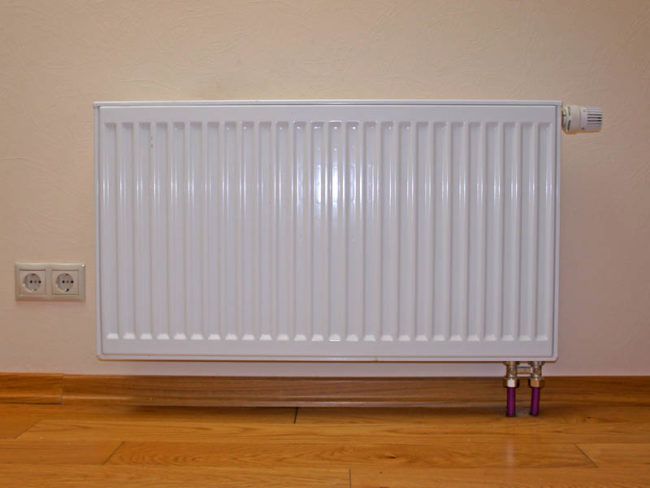
Tubular steel battery
Unlike panel batteries, tubular radiators are a structure consisting of several sections, fastened together by welding.Depending on the area of the room and the heating effect, it is necessary to calculate the power of the finished module and choose the optimal size. The small thickness of the pipes from 1.5 to 2 mm warns to be careful and try to use such structures only for low-rise buildings with closed systems.
Normal operation of tubular steel batteries is possible at a pressure of 8-10 atmospheres. If the central heating system “sins” with pressure jumps, then it would be advisable to install a reducer to smooth out the voltage.
Due to the small thickness of the walls, the coolant quickly heats up the steel structure. Today, the market offers a huge selection of tubular steel batteries in a variety of design solutions. They are installed not only traditionally at the window or wall, but even in the center of the room. Some designs are made in the form of a bench, the footboard of which is a heating device. It is advisable to install such a battery in the corridor. During the day, it will be comfortable to wear shoes on it, and at night it will be possible to place shoes on a chair to dry.
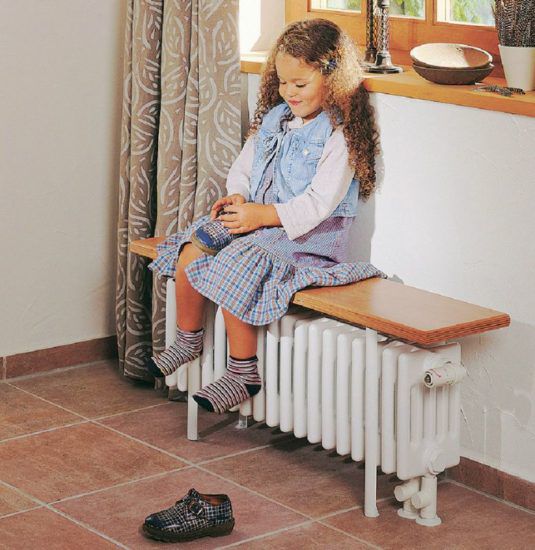
Bench-shaped steel battery
Pros:
- Rapid heating. Due to the thin walls (1.5 mm), the heating of the batteries occurs in a matter of minutes, which allows you to save on utilities (in the event that a meter is installed in the apartment). However, this plus can also turn into a minus. Thin walls are subject to mechanical destruction of the "dirty" water supplied by the central heating system.
- Higher resistance to mechanical damage compared to panel batteries.
- Large selection of styles.Given the rich selection of colors, such radiators are easy to choose for almost any interior of the apartment. There will be no need to spend effort and money on additional decoration in the form of screens.
Minuses:
- Vulnerability to powerful water hammer of the central heating system. However, almost all devices connected by welding are guilty of this drawback. During a powerful pressure drop, the structure may begin to collapse at the junctions.
Summing up, it should be said that tubular steel batteries are far from the best option for an apartment. Installation in a house with independent heating will lead to unnecessary costs due to rapid cooling. And installation in an apartment with central heating can cause emergency situations.
Features of mounting steel radiators
Steel batteries are quite easy to install, but it is better not to remove the packaging film until the end of the installation work. This will keep a clean look and not disturb the outer coating of the panel. The distance to the floor and wall is different for each model, so carefully study the installation diagram in the instructions.
Depending on the type of construction, we select the mount. We will attach the hinged radiator to the wall using brackets and dowels. The floor structure is installed on the floor on conventional racks and traditionally connected to the heating pipe.
Steel radiators are easily integrated into the heating system and, depending on the model, have a different type of connection: side, bottom, top. The distance between the wall and the rear panel of the steel radiator must be at least 25 mm, otherwise, the heat transfer of the device will be significantly reduced.
Modern models have a locking system against accidental “dismantling”, therefore, before installing the device, it is necessary to pull up the mounting grip and fix it in this position. We begin the installation with the lower fasteners, and after that we put on the upper ones. If you have done everything correctly, the top fastener will automatically snap into place, securely fixing the radiator to the wall.
aluminum batteries

aluminum battery
Despite their beautiful appearance, aluminum radiators are not the best choice for heating an apartment with a central system. In apartments with an autonomous heating system, this choice of batteries is very popular. Along with a stylish appearance, they are distinguished by reliability and a fairly long service life - 20-25 years.
The material for creation is aluminum with the addition of silicon alloys, which gives the batteries a special strength. In industry, as a rule, silumin and duralumin are used to improve technical properties. In addition, the addition of silicon alloys can reduce the cost of the original product.
The design of aluminum batteries is quite simple: each section consists of two horizontal channels of large diameter and one vertical one with a smaller diameter. Several ribs depart from the vertical channel, which "take" thermal energy from hot water and "give" it to the air.
Designed for a pressure of 15 atmospheres, they are very vulnerable to air locks and water hammer. The connection of individual sections is carried out using the coupling threaded method, which allows you to quickly install the battery.
The tightness of aluminum radiators is achieved through the casting method. Each section is cast in a separate mold, after which it is combined into one common structure.
Aluminum radiators of various shapes and sizes are presented on the market, which allows you to choose the best option for the finished design of the apartment. Depending on the area of the room and the heating effect, the size of the aluminum battery is also selected.

An aluminum battery can become a design element in an apartment
Batteries produced using injection molding technology have a higher margin of safety against pressure drops. The working pressure in them reaches 16 atmospheres, but during testing, the manufacturer tests radiators with a pressure of 25 atmospheres, which sometimes allows the batteries to withstand sudden surges. The smooth surface of cast panels provides higher heat dissipation.
Another method of manufacturing aluminum batteries is extrusion. This significantly reduces the cost of the product, but in terms of technical characteristics it is inferior to cast batteries. Recycled aluminum is used as the main raw material here, which over time leads to brittleness and corrosion. Therefore, when choosing radiators, it is necessary to focus not only on the material, but also to clarify the production method. Batteries produced using extrusion technology cannot be extended. They go on sale already in a standard size.
Aluminum radiators have a fairly low weight, which greatly simplifies their installation, which can be done independently. Due to the high heat dissipation of aluminum, the batteries heat up very quickly. This allows you to control the flow rate and manually control the system, creating a comfortable room temperature.
Pros:
- Corrosion resistance.
- Stylish appearance.
- Light weight (3-4 times lighter than cast iron).
- Variety of colors.
- High heat dissipation.
- Variety of sizes.
- Possibility to add sections during operation (only applicable for the casting method).
Minuses:
- Sensitivity to pressure drops.
- Dependence on water quality. With contaminated water with a high pH, the structure can quickly fail.
Features of mounting aluminum batteries
When installing aluminum batteries, one should, first of all, focus on the technical properties of the material. If during the installation of cast-iron batteries the main feature was a lot of weight, then the opposite is true here. Aluminum batteries are light and fragile, so installation should be carried out very carefully without removing the packaging.
The surface of an aluminum radiator can be damaged during installation even from a slight blow with a tool. Aluminum batteries are already on sale complete with brackets, which can be easily attached to the wall with dowels.
To create the most efficient heat transfer, you should be guided by the following parameters during installation:
- The distance between the window and the heating panel should not exceed 10 cm.
- The distance to the wall is 3-6 cm.
- The distance from the panel to the floor should be within 5-6 cm.
A shut-off valve is installed on both sides of the radiator for temperature control and for emergencies.
After completing the installation and before connecting to the heating system, it is necessary to “pressurize” the device. To do this, call a representative of the relevant service or buy a crimping machine.
Anode radiators
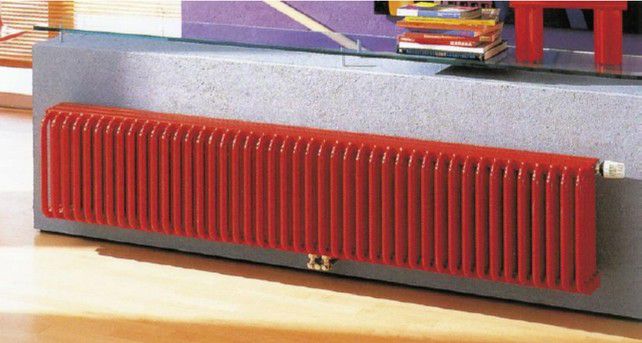
Anode radiator
In fact, these are also aluminum batteries. Only the raw material (aluminum) undergoes more severe cleaning with anodic oxidation of the surface. This improves resistance to corrosion and the chemical attack of dirty water.
Anode batteries are produced using casting technology, which provides them with tightness and resistance to water hammer. They are able to withstand pressure of 20-25 atmospheres. Due to the fact that the individual sections are assembled using threaded couplings and hermetic seals, the battery can be disassembled and supplemented.
Due to the perfectly smooth surface of the inside of the radiators, maximum heat transfer and more efficient circulation of hot water inside the structure is achieved. Externally, anode radiators are also pleasing to the eye. Their smooth shape and smooth surface are safer than the angular design of cast iron batteries.
The only drawback of anode structures, perhaps, is their high cost compared to aluminum radiators.
Pros:
- High heat dissipation.
- A variety of sizes and the possibility of adding sections during operation.
- Withstand high pressure (20-25 atmospheres).
- Corrosion resistance.
- Stylish appearance.
Minuses:
- High price.
Anode aluminum batteries are great for apartments with both central and autonomous heating systems. If financial possibilities allow, then such radiators will last a very long time, delighting with their practicality, functionality and excellent appearance.
Installation of anode batteries is carried out in the same way as the installation of aluminum radiators (see above).
Bimetal radiators

Bimetal radiator
These batteries demonstrate the best value for money. They are able to withstand sufficiently excessive pressure, and are not too demanding on the coolant. This is what determines their current popularity in the construction market, which is second only to cast iron batteries.
The name of the radiators already indicates that they are assembled from two materials. The outer part is made of aluminum, and the inner layer is made of high quality copper alloy or steel. This combination of materials allows us to solve two problems at once: to improve heat transfer and increase corrosion resistance. The enamel coating in any color scheme gives the batteries a beautiful appearance.
The bimetallic radiator is available in two versions:
- Absolutely bimetallic apparatus, which is characterized by increased strength and resistance to pressure drops in the network. Their service life is at least 25 years, which fully justifies the high price. In such a device, the core is made in the form of pipes through which water flows without contact with the body itself.
- Semi-bimetallic is a design, the internal channels of which are simply reinforced with plates of another metal.
The design of bimetallic radiators consists of several sections, which are interconnected using a threaded coupling. If desired, you can always buy more sections and build up.
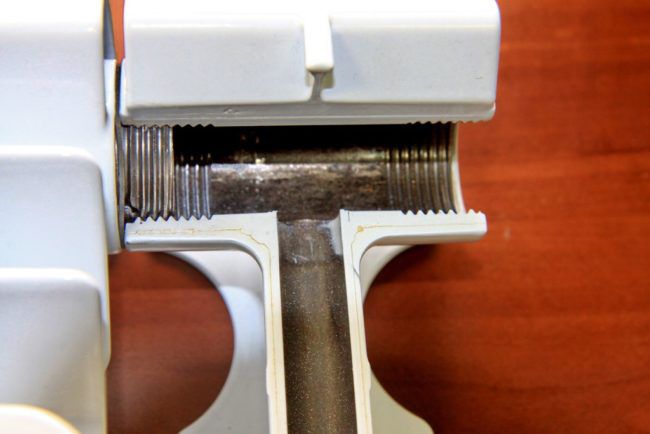
The battery element in the cut. Visible connection thread
Bimetal radiators will be the best choice for apartments with a central heating system due to their high resistance to high pressure of 35-40 atmospheres. They are not afraid of sudden changes in operating conditions.
Pros:
- They heat up quickly and give off heat easily.
- Corrosion resistance.
- Stylish appearance.
- Large selection of sizes.
- Possibility to deliver sections during operation.
- Withstand strong water hammer.
- Light weight and easy installation.
Minuses:
- High price.
Such radiators should be purchased only in specialized stores, subject to familiarization with the documentation.Outwardly, they cannot be distinguished from aluminum batteries, but the difference in price will be very noticeable.
Bimetal radiators are a great option for apartments with any type of heating. The high price is offset by a long service life.
Features of mounting bimetallic radiators
The basic rule for the installation of bimetallic radiators is that the installation is carried out in a package. Do not remove the film until all work is completed. The fact is that the outer surface of the radiators is quite fragile and can be damaged by the impact of a tool.
Do not clean the parts to be joined with a file or emery, in order to avoid water leakage in the future.
In order for the bimetallic radiator to work properly and efficiently, the following distance requirements must be followed during installation:
- The distance from the wall to the device is 3-5 cm. If you install it closer to the wall, the natural air circulation will be disturbed, which will significantly reduce the efficiency of the device.
- The distance from the floor is no more than 10 cm. If you install it lower, this will not only reduce the efficiency of heat transfer, but also make it difficult to maintain the radiator in the future.
Start the installation by attaching the brackets to the wall, having previously marked out. Each radiator must be equipped with an air release valve. This will help prevent air pockets in the future. Use a torque wrench to securely tighten the valve.
Video. Do-it-yourself installation of bimetallic radiators
Copper radiators

copper heatsink
Perhaps the only significant drawback of this type of radiators is their high price. Otherwise, they are distinguished by high technical properties, have a magnificent appearance and will last at least 25-30 years with proper care.
Copper batteries level the resistance of the coolant, increasing its efficiency. High efficiency is due to high thermal conductivity. Compared to the popular cast iron - 4 times more.
Pros:
- Corrosion resistance.
- Withstand high pressure in pipes (30-36 atmospheres).
- High heat dissipation.
Minuses:
- High price.
Features of mounting copper radiators
- The ideal material for pipes to which the radiator is soldered is copper. This will provide a seal and prolong battery life. When combined with other types of metal, corrosion can form over time. This also applies to the choice of fittings.
- Before installing a copper battery, it is necessary to install a filter designed to purify water. Otherwise, during operation, the inside of the device may become rough, which will provoke the deposition of salts.
- All structural elements are connected by soldering.
- On the brackets with which copper pipes are attached to the wall, it is necessary to install rubber pads, which will help protect the surface of the pipes from deformation and corrosion.
Video. How to install heating radiators
How do the features and nuances of the central heating system affect the service life of radiators?

Central heating system
Before you start choosing a radiator for your apartment, you should take into account some of the nuances of the central heating system. Of course, central heating has more advantages than disadvantages. No need to bother with the selection and installation of boilers, installation of a chimney. The cost of utilities is easily controlled by installing a meter. But there are also disadvantages that affect the choice of batteries.
- The composition of the carrier always contains aggressive substances that adversely affect the material of pipes and batteries. Most often, it is corrosion that causes a destructive effect on the inner layer of radiators, reducing the service life. As a preventive measure, some utilities add lignosulfonate powder to water tanks, which does not have the best effect on the service life of radiators.
- In the water that goes through the pipes for heating, fine sand, clay, and lime are often present. Gradually, this small debris wipes the metal from the inside. If the inner layer is rough, it will shorten the service life much faster.
- One of the enemies of heating radiators in apartments is pressure drops, the so-called water hammer. This, of course, negatively affects the condition of the batteries. Air locks created by the unstable operation of the central line gradually lead to cracking and rupture of the metal. But many modern radiators are equipped with protective valves that allow you to regulate the pressure in the pipes and thus deal with pressure instability.
- The instability of the temperature of the heating system has the greatest effect on the internal part of the battery. Cast iron tends to expand when heated and shrink when the temperature drops, which leads to cracking of the inner layer. Therefore, it is these batteries that are most vulnerable to temperature changes.
Therefore, when choosing a radiator for heating an apartment, be guided by these points and take into account the operation of the highway and local housing and communal services.
Calculator for calculating the number of sections of heating radiators
How to choose the right radiators for an apartment?
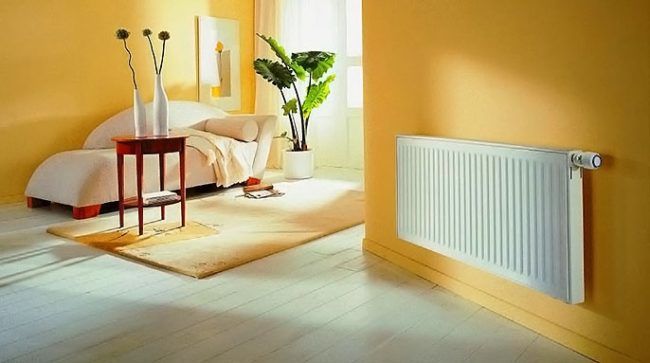
Radiators should not only perform their functions, but also fit into the interior
Choosing a radiator for an apartment is a crucial step. Not all types of heating systems on the market today are suitable. Some appliances are not capable of withstanding the stress and water hammer that is common in our utilities. Here it is important to consider not only the material, but also the maximum load of the radiator.
In addition, for the efficient operation of the heater and its maximum heat transfer, it is necessary to correctly calculate number of sections.
When choosing a radiator for an apartment, the following factors must be considered:
- The total area of the apartment. Based on this parameter, it is necessary to select the power of the radiator.
- Maximum pressure in the heating system. Each device has its own load limit.
- The material and the maximum temperature that the radiator can withstand. Radiator power. This will be a fundamental factor, based on which it is necessary to calculate the number of sections and the total length of the device.
- General design and style of batteries.
When choosing batteries for your apartment, you do not need to be overly prudent. A low price can cause cold in the room, and the service life of inexpensive radiators does not exceed 5-6 years.
In the event of an accident in the central heating system, cheap batteries can quickly fail due to water hammer.
At the end of the article, we offer you a very detailed lecture on choosing radiators for an apartment.
Video: How to choose heating radiators


